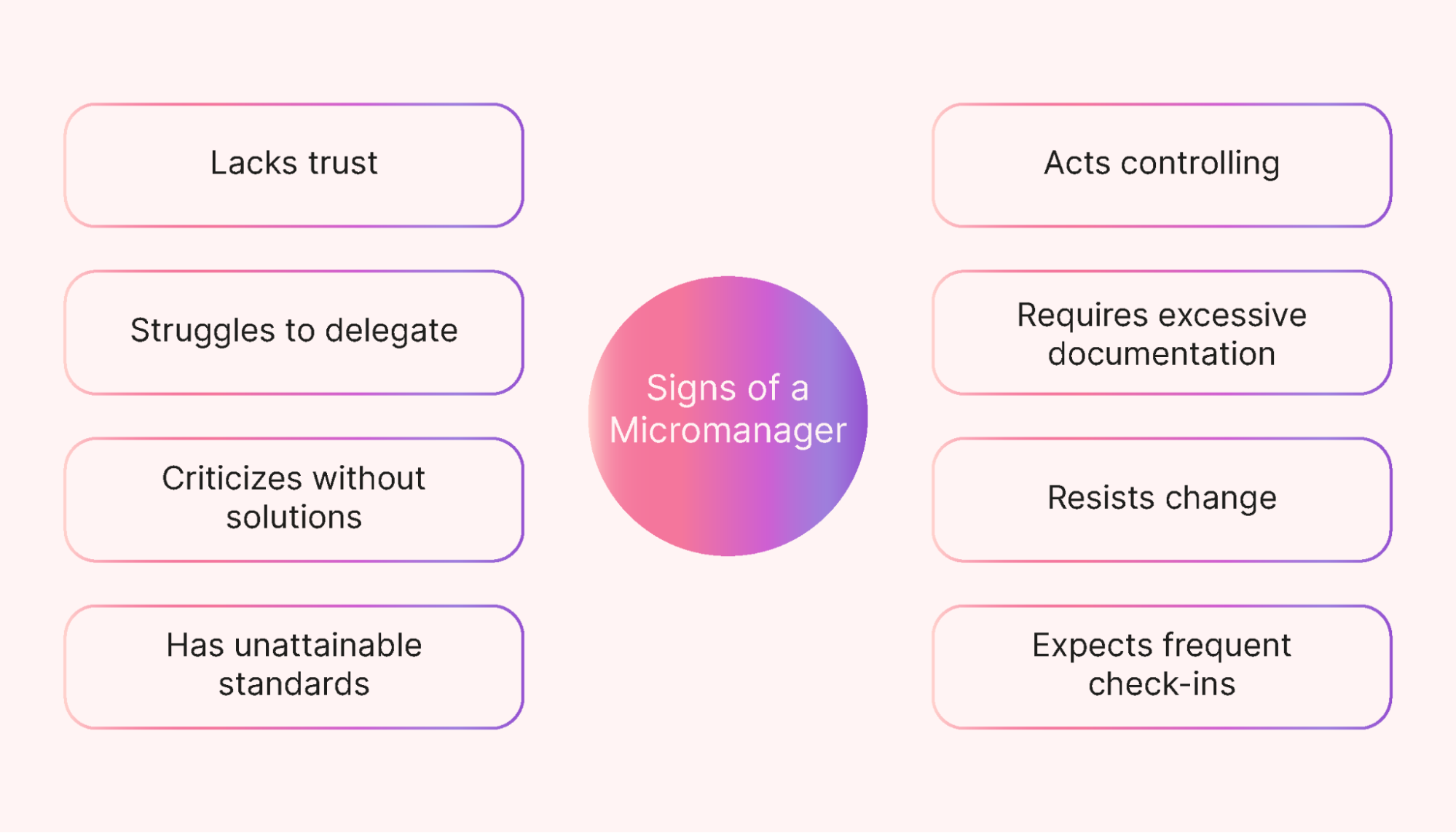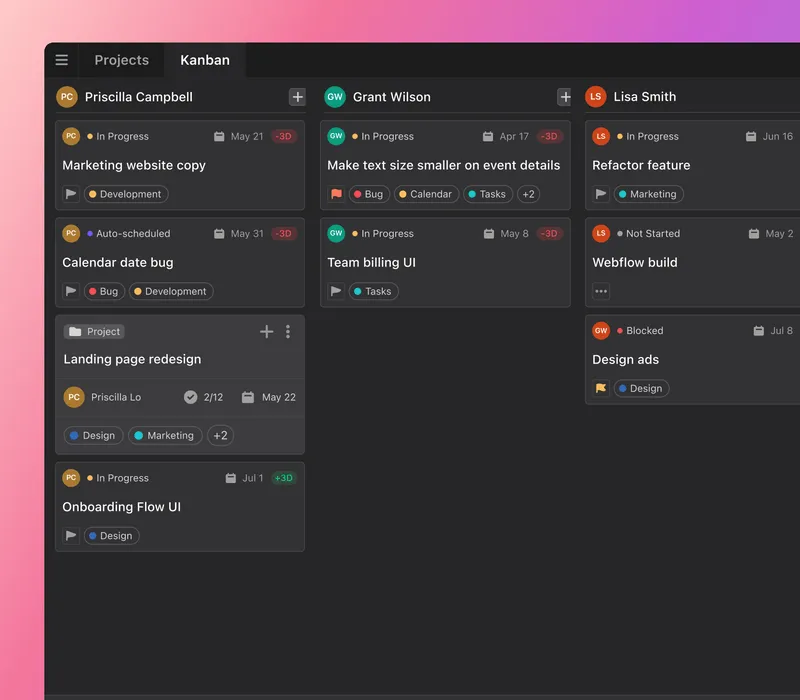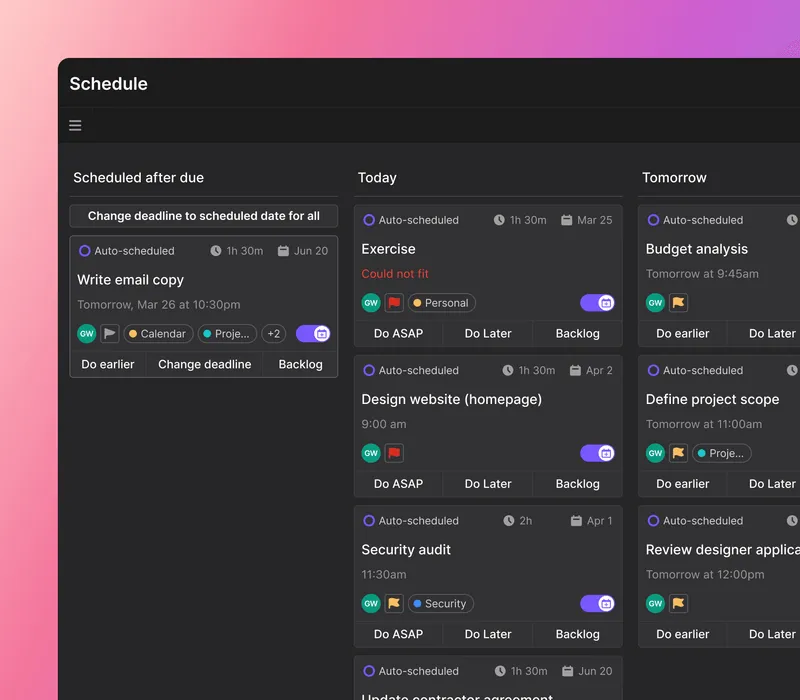No one likes being micromanaged. It’s overwhelming, condescending, and makes you feel like you’re doing a crummy job.
But what are you supposed to do when you’re being micromanaged? That’s your manager, after all. You can’t just tell them to back off (as satisfying as that would be).
The good news is that you can handle micromanagers in a few ways. In this article, we outline a few tips to help you deal with being micromanaged in 2023 (spoiler alert — using the right technology could be the answer you’ve been looking for).
What is a micromanager?
A micromanager is a type of manager, supervisor, or business leader who is controlling and overly involved in the day-to-day tasks of their employees. They tend to closely monitor and scrutinize other people’s work to ensure the best possible quality is being produced.
But in doing so, micromanagers can hinder productivity, stifle creativity, and decrease employee morale — all of which can impact the overall quality of work.
 |
So why do micromanagers behave this way?
Here are some of the possible reasons.
- Fear of failure. A micromanager usually doesn’t handle failure very well. As a result, they become overbearing in an attempt to make everything successful.
- Perfectionism. Some micromanagers simply desire everything to be perfect, which isn’t realistic. They try to control as much as possible so they feel it meets their standards.
- Lack of effective communication. There are no boundaries if you don’t have effective communication processes in place. For a micromanager, they don’t feel in control of what you’re working on, so they tend to check in too often to compensate.
- Pressure from higher-ups. If your manager feels pressure to deliver and perform well, this can translate into micromanagement. They want to show their boss that they’re doing a good job, so they become controlling over the work that you’re completing.
The psychological effects of micromanagement
Being micromanaged can have a profound effect on our ability to work. It can knock our confidence, our trust in our abilities, and even impact our mental health.
In fact, one study found that 56% of employees feel stress and anxiety about their employer surveilling their communications. Another study found that people who feel micromanaged are much more likely to feel tense (64%) and stressed (36%) during their work day.
The same survey gathered the following feedback from one of its female participants:
“Stop micromanagement. It is so stressful to me. Let me do my job as hired to do.”
These potential psychological effects are why it’s important to address these challenges with your manager. Their behavior might come from a good place, but changes need to be made when it impacts your state of mind.
How to spot a micromanager
If you’re reading this article, chances are you already know how to spot a micromanager. But to offer some clarity, look at this image, which outlines some common traits.
 |
Let’s look at these in more detail.
- Lack of trust. Trust issues are one of the key indicators of a micromanager. If your manager doesn’t trust you to complete the work you’ve been given, they may do it themselves (which leads nicely to the next point).
- Struggles to delegate. Most micromanagers are perfectionists. This means they often prefer to do work themselves and do it “properly” rather than delegate it to someone else and have it done incorrectly.
- Criticizes without solutions. Micromanagers can be extremely critical of other people’s work without offering a solid solution to improve it. For example, they might tell you that your report isn’t detailed enough but fail to tell you where it’s lacking in detail.
- Has unattainable standards. It can be impossible to reach the standards a micromanager has set. The work may be unrealistic, unachievable, or unreasonable to complete within a certain timeframe.
- Acts controlling. Control is a key aspect of micromanagement. An example could be if your superior wants to know what you’re doing every second of the day. This is pretty classic micromanagement behavior.
- Requires excessive documentation. As discussed, a micromanager struggles to trust people and has issues with control. So, it makes sense that they need excessive documentation to back up your work. They want to see everything to ensure it meets their standards.
- Resists change. Micromanagers don’t cope well with unplanned or unstructured change. If you suggest changing your schedule or updating the scope of work, they might not receive it well.
- Expects frequent check-ins. A micromanager will expect frequent communication from you. This usually takes the form of daily updates, which can be draining and time-consuming.
This isn't a complete list of micromanagement traits. Some micromanagers may display all these signs, while others might show other traits. But spotting a micromanager boils down to this question: do they trust you to do your work or not?
4 tips for handling a micromanager in 2023
Research shows that micromanagement is one of the top three reasons people resign. If you want to put things right and avoid handing in your notice, keep reading.
We’ve outlined four ways you can deal with a micromanager sensitively and effectively.
1. Show them you can be trusted
Often, micromanagers feel the need to control because they don’t trust that other people will do the job well. To prevent them from being so controlling, show them you’re trustworthy and dedicated to your work.
Here are some tips for building trust with your manager:
- Meet deadlines. Hit all your deadlines on time to show your manager you’re serious about your work (or early if you want to show them you're reliable).
- Provide quality work. Fifty-four percent of employers say producing quality work earns trust. So, you must deliver your work to the highest standard possible. This will show your manager that you care about the job and want to meet their expectations.
- Support business goals and objectives. Show that you’re loyal to the company's development by supporting business goals and objectives with your work. For example, if the company wants to improve collaboration, ensure you do your best to incorporate collaboration into your day-to-day work.
2. Be frank about it (but don’t be rude)
Talk to your manager if you’re struggling with being micromanaged. Sure, it sounds like a scary and difficult conversation — but being open and honest can break down the barrier and set your working relationship in a new direction.
Studies have shown that honesty with your employer can build trust, which is another way to break down the barriers.
Here are a couple of ways to have this conversation respectfully:
- Don’t place blame. Explain how you feel in this situation and avoid any language blaming your manager. That way, it’s more about your feelings than their behavior.
- Offer a solution. If you’re coming to your manager with this problem, having a potential solution in mind is helpful. For example, if your manager requires frequent updates, you could suggest a weekly call instead to relieve some of the pressure.
3. Set clear expectations
To relieve some tension and help your micromanager boss release some control, it helps to have clear boundaries and expectations in place.
For example, if your manager asks you to complete a task, you can define a specific deadline to avoid constant check-ins. With these boundaries in place, your manager can sit back and wait until the deadline for an update.
Or, if you want to put their minds at rest, you can use a tool like Motion to schedule your work.
As an online work management platform, Motion allows teams to access schedules and share regular updates in a central platform. This means your manager can log in and see where you are with your work without asking for an update.
 |
Find out more about using Motion for teams.
4. Get the right technology in place
This follows our previous point, where using technology to keep your manager in the loop can relieve some pressure and tension.
Think about it. With online, real-time technology, your manager can see what’s in your schedule, how you’re progressing with tasks, and when the tasks are due (which is especially helpful for remote teams). It puts their mind at rest and prevents them from micromanaging your day-to-day work.
A platform like Motion is incredibly helpful here.
 |
With our software, your manager can keep track of deadlines and access real-time progress without asking you for an update.
Increase transparency with Motion
Micromanagers can have good intentions. They want to deliver top-quality work, but it can be pretty intense working for them. Hopefully, you’ve got a good idea of how to handle this situation.
If you want to implement some technology to increase transparency and improve communication, sign up for a free trial with Motion. Use our work management system to show your manager what you’re working on, keep in touch, and minimize the need for constant check-ins.





